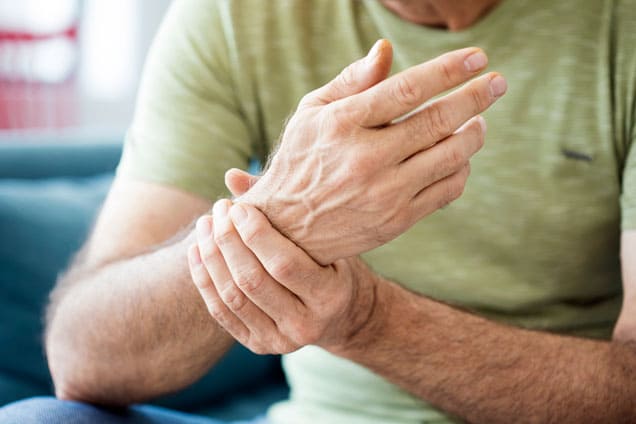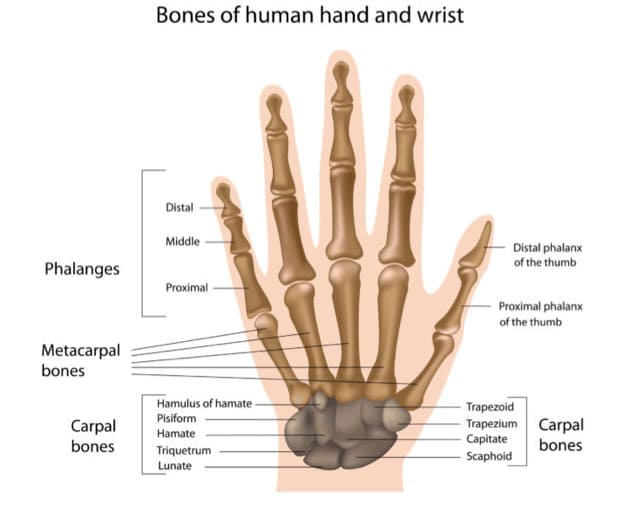Hand Pain
09
July
2021

One of the most tedious limbs in the human body, the hands are considered more vulnerable to injury than we presume. An injury in the hand can occur from a multitude of causes and will most likely cause major discomfort due to the fact that we use them for practically everything. People tend to overlook the complex structure of the hands and ignore the fact that a hand injury does not only mean a wrist sprain or a broken finger, but includes injuries in one’s joints, connective tissues, tendons, and nerves.
What is my hand made out of?
Without overcomplicating it, let’s break down what your hands are made out of. Your hands are made out of bones, ligaments, muscles, and the ropes which give the ability of moving to your fingers and wrist. The bone section itself is divided into three main ones:
Phalanges: These are the bones that every finger and every toe are made out of. Each finger is made out of 3 of these phalange bones except the thumb that is made out of 2.
Metacarpal bones: These are the bones that make out the biggest chunk of your hand, from the knuckles all the way to right above your wrist.
Carpal bones: These are the bones that make out the wrist. Made out of 8 bones, your wrist is also connected to two bones in the arm.

In addition to the many bones in the limb, numerous muscles, as well as fibrous tissues called ligaments, are what bind the muscles to each other and aid the arm in contracting and moving in general.
If you are asking yourself why it’s important to understand the anatomy of your wrist, the answer is simple. Not only your hand is a limb that you use for literally everything, from eating, to showering, exercising, and even reading this blog post, it is also a fascinating organ housing several other organs: “The hands have 29 major joints, at least 123 ligaments, 34 muscles, 48 nerves and 30 arteries.” (East West College, 2021). A hand is made out of very little and delicate elements, so understanding what it’s made out of, how you may injure it, and how you can prevent it, will not only make your life hassle free, but may help you prevent severe conditions.
Why is my hand hurting?
As proven above, hand injuries are more complex than we think. Hand pain can be caused by an injury as straightforward as a hand break or fracture, or can be as elaborate as carpel tunnel syndrome or ganglion cysts. These are some of the causes why you may be experiencing hand pain:
Repetitive motion: Performing the same movement over and over again while applying the same or more pressure each time is bound to cause pain on the wrist. However, if overdone, the pain may be higher than one might expect, and if ignored, the recovery journey would be longer. activities that are considered “dangerous” when overdone are typing or using a computer mouse, sports, heavy lifting, hand focused jobs
Wear & Tear: They say that the older you get the wiser you are, but no one prepares you for the fact that the older you get the weaker your joints may become. Hand pain may occur with weaker joints due to the wearing down of cartilage present between the bones, causing them to rub together.
Injury Trauma: As hands are one of the most used limbs in the body, they are constantly exposed to danger. This means that traumatic incidents involving the hands are very common but should not be neglected. Any injury involving the hands must be treated with the utmost care due to the fact that a poorly healed injuries can permanently change the structure of the hands as well as its abilities to perform its day-to-day actions.
Tendonitis: This injury involves the tendons in the hands. Tendons are thick tissues, and are the reasons why muscles can stay “strapped” to the bone. Performing rigorous movements repeatedly could cause inflammation to the tendons in the hand. The most common example of tendonitis is tennis elbow. It is very common in tennis players who repeat the same back and forth movement for a long period of time at a time. Tennis elbow, as shocking as it might seem to some, does not only affect tennis players but anyone who has to undergo the same up and down or back and forth movement continuously. This includes painters, plumbers, butchers, or anyone who uses a computer mouse all day.
Arthritis: Arthritis, is an injury that involves the inflammation of the joints in the hand. It is important to note that it can occur anywhere in the body, but it is mostly common in the hands and wrists. While there are over 100 types of arthritis there are two common that go by the name Osteoarthritis and Rheumatoid. Without going into too much detail, osteoarthritis is a condition that mostly affects older individuals and is a side effect of the wear and tear of the joints. The latter condition is a chronic disease, that causes pain and stiffness in one’s hand due to inflammation of the joints.
Carpal tunnel syndrome: This nerve disorder, is the cause of discomfort and pain in palm, fingers, wrist, and forearm of so many individuals. To better understand this syndrome, defining carpal tunnel is a must. This cluster of bones and connective tissues at the bottom of hand is the structure that is home to the median nerve, the nerve that controls sensation and muscle impulses in the thumb and most of the fingers. An injury to the carpal tunnel causes a pinch to the median nerve which causes, inflammation, numbness and pain to the areas of the hand who are concerned.
Lupus: Lupus is an autoimmune disease that affects around 5 million people worldwide. A person attained by an autoimmune disease has to live with their immune system mistakenly attacking healthy cells and damaging healthy tissue. Joint pain and stiffness are said to be the first symptoms or indications of lupus. A lupus flare causes inflammation throughout the body and joint lining to swell which explains the joint discomfort.
Ganglion cysts: These non-painful lumps on the back of the wrist, are fluid filled sacs that can be easily treated. They cause discomfort due to the fact that they apply excess pressure on the nerves of the hand which makes it hard to move the wrist without the sensation of numbness, tingling or pain in the concerned area.
Trigger Finger: Trigger finger is the simplified version of an injury called stenosing tenosynovitis. This painful injury is described by having one of the 10 fingers or the thumb stuck in a bent position. The fixed bent position is due to the inflammation of tunnels in the fingers, making it harder for the tendons to slide through their designated tunnels. The tendon gets stuck when one forcefully tries to straighten or bend the finger while it is inflamed.

How do I know my hand is hurting?
Other than pain sensation, here are some things to look out for when deciding whether the hand pain is severe of not:
Not being able to make a fist without feeling pain
Not being able to turn your wrist without feeling pain
Not being able to carry objects without feeling pain
Stiffness of the hand or finger (s)
Swelling of the hand or finger (s)
Loss of movement of the hand or finger (s)
Feeling of burning or dull pain in joints of fingers or wrist
Feeling of warmth in the affected area
Feeling of numbness, throbbing, or prickling in the fingers or joints
Feeling of severe muscle pain.
Sensation of popping or snapping as one is straightening and bending a finger.
Can I treat my hand pain at home?
In some cases, hand pain may not rank high on the importance scale which gives patients the ability of treating their injury at home. To treat your injury in a safe way, follow these steps.Apply cold or heat, depending on the injury. If one is experiencing stiffness then a hot compression is the best option, as a cold compression is better for swelling.
For a short-term relief, get a hold of over-the-counter pain medication.
Stabilize the injured joint by buying a splint from the nearest pharmacy. This will avoid the patient from further injuring themselves while they heal.
However, it is important to keep in mind that as soon as the pain becomes unbearable, don’t try to treat it yourself and visit the appropriate doctor.
When should I see my doctor?
If you have tried one of the home remedies and the pain/discomfort did not seem to go down, then visit your doctor is the next best thing. Some problems do develop gradually, so over the course of your recovery, look up for returning or new apparent symptoms that may trigger a red flag. In the occurrence of a traumatic injury, one’s first instinct should be the emergency room for any form of X-Ray of MRI.
Outlook
As the hand is made out of very small and multiple elements, injuries are very probable but are important and should not be ignored. Treating your hands as importantly as other parts of the body and taking the right measure to prevent injury as well as insure a safe and effective recovery is crucial.
If you or anyone you know is suffering from pain, call us today on (469) 562 4188 to book an appointment with our expert doctors.